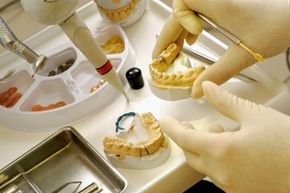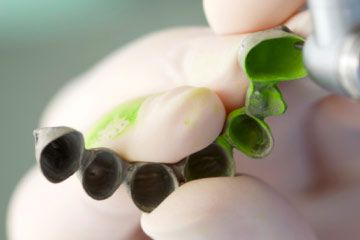The issue of tooth replacement can get confusing, so let's simplify things a little bit. A partial is a dental prosthetic (artificial tooth or teeth) that can be removed from the mouth somewhat like an orthodontic retainer. A bridge, on the other hand, is a dental prosthetic that's permanently anchored inside the mouth.
Partials are sometimes referred to as RPDs (removable partial dentures). They're often selected as an inexpensive option over a bridge or dental implant for replacing lost teeth. Most partials work in a similar way: Artificial teeth are placed on a molded base to which metal clasps are added. The clasps look like small hooks and fit around the existing teeth situated on either side of the missing tooth or teeth. The base, typically an acrylic tinted pink to look like flesh, rests on the gums (and the roof of the mouth for upper teeth). The clasps and base stabilize the prosthetic, helping to hold the teeth in place.
Advertisement
A partial can be a practical option, particularly when there's the potential for additional future tooth loss. New teeth can be added to a partial pretty easily and inexpensively. Although many of the partials currently in use are made from rigid acrylic with metal clasps, the use of nylon is becoming more widespread. Nylon is a very strong material that can be used to form the framework as well as the clasps, eliminating the need for metal. Another popular new partial material is vinyl. It can be employed to create a flexible base that's more comfortable to wear than rigid acrylic and easier to modify if adjustments become necessary.
Bridges are quite different from partials. They're fixed, permanent, partial dentures. Installing a bridge requires shaving the teeth on either side of the missing teeth and adding porcelain crowns to create anchors for the prosthetic device. The term "bridge" is apt because these types of dentures span the gap between neighboring teeth and are affixed to those neighboring teeth, relying on them for stability and support.
Advertisement

